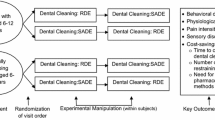Abstract
Many persons with intellectual and developmental disabilities resist basic dental care leading to poor oral health. The present study evaluated the effects of a dental desensitization intervention for two students who had autism spectrum disorder and would not tolerate tooth cleaning and examination. Intervention consisted of gradually exposing the students to steps within a desensitization hierarchy, reinforcing compliance, and progressively fading-eliminating reinforcement. Familiar care-providers implemented intervention within a simulated dental setting at their school. Both students completed intervention successfully and one of them was able to tolerate procedures during visits to a dentist’s office. We discuss the clinical and research implications of these findings.


Similar content being viewed by others
References
Altabet, S. C. (2002). Decreasing dental resistance among individuals with severe and profound mental retardation. Journal of Developmental and Physical Disabilities, 14, 297–305.
Clevenger, W. E., Wigal, T., Salvati, N., Burchill, R., & Crinella, F. M. (1993). Dental needs of persons with developmental disabilities in Orange County. Journal of Developmental and Physical Disabilities, 5, 253–264.
Conyers, C., Miltenberger, R. G., Peterson, B., & Barenz, R. (2004). An evaluation of in vivo desensitization and video modeling to increase compliance with dental procedures in persons with mental retardation. Journal of Applied Behavior Analysis, 37, 233–238.
Cuvo, A. J., Godard, A., Huckfeldt, R., & DeMattei, R. (2010). Training children with autism spectrum disorders to be compliant with an oral assessment. Research in Autism Spectrum Disorders, 4, 681–696.
Duker, L. I. S., Henwood, B. F., Bluthenthal, R. N., Juhlin, E., Polido, J. C., & Cermak, S. A. (2017). Parents’ perceptions of dental care challenges in male children with autism spectrum disorder: An initial qualitative exploration. Research in Autism Spectrum Disorder, 39, 63–72.
Fisher, W., Piazza, C. C., Bowman, L. G., Hagopian, L. P., Owens, J. C., & Slevin, I. (1992). A comparison of two approaches for identifying reinforcers for persons with severe and profound disabilities. Journal of Applied Behavior Analysis, 25, 491–498.
Hernandez, P., & Ikkanda, Z. (2011). Applied behavior analysis: Behavior management of children with autism spectrum disorders in dental environments. Journal of the American Dental Association, 142, 281–287.
Kancherla, V., Braun, K. V. N., & Yeargin-Allsopp, M. (2013). Dental care among young adults with intellectual disability. Research in Developmental Disabilities, 34, 1630–1641.
Kazdin, A. E. (2011). Single-case research designs in clinical and applied settings. New York: Oxford University Press.
Loo, C. Y., Graham, R. M., & Hughes, C. V. (2008). The caries experience and behavior of dental patients with autism spectrum disorder. Journal of the American Dental Association, 139, 1518–1524.
Luiselli, J. K. (Ed.). (2016). Behavioral health promotion and intervention in intellectual and developmental disabilities. New York: Springer.
Maguire, K. B., Lange, B., Scherling, M., & Grow, R. (1996). The use of rehearsal and positive reinforcement in the dental treatment of uncooperative patients with mental retardation. Journal of Developmental and Physical Disabilities, 8, 167–177.
Nikopoulos, C., Luiselli, J. K., & Fischer, A. J. (2016). Video modeling. In J. K. Luiselli & A. J. Fischer (Eds.), Computer-assisted and web-based innovations in psychology, special education, and health (pp. 187–210). New York: Elsevier/Academic Press.
Owens, P., Kerker, B., Zigler, E., & Horwitz, S. (2006). Vision and oral health needs of individuals with intellectual disability. Mental Retardation and Developmental Disabilities Research Reviews, 12, 28–40.
Petrovic, B. B., Peric, T. O., Markovic, D. L. J., & Vujkov, S. (2016). Unmet oral health needs among persons with intellectual disability. Research in Developmental Disabilities, 59, 370–377.
Stein, L. I., Polido, J. C., & Cermak, S. A. (2012). Oral care and sensory concerns in autism. The American Journal of Occupational Therapy, 66, 73–76.
Stein, L. I., Lane, C. J., Williams, M. E., & Cermak, S. A. (2014). Physiological and behavioral stress and anxiety in children with autism spectrum disorders during routine oral care. In BioMed Research International (Vol. 2014, pp. 1–10).
Turner, S., Sweeney, M., Kennedy, C., & Macpherson, L. (2007). The oral health of people with intellectual disability participating in the UK Special Olympics. Journal of Intellectual Disability Research, 52, 29–36.
Author information
Authors and Affiliations
Corresponding author
Ethics declarations
Ethical Approval
All procedures performed in studies involving human participants were in accordance with the ethical standards of the institutional and/or national research committee and with the 1964 Helsinki declaration and its later amendments or comparable ethical standards.
Informed Consent
Informed consent was obtained from the parents of both participants included in the study.
Conflict of Interest
The authors declare that they have no conflict of interest.
Rights and permissions
About this article
Cite this article
Carter, L., Harper, J.M. & Luiselli, J.K. Dental Desensitization for Students with Autism Spectrum Disorder through Graduated Exposure, Reinforcement, and Reinforcement-Fading. J Dev Phys Disabil 31, 161–170 (2019). https://doi.org/10.1007/s10882-018-9635-8
Published:
Issue Date:
DOI: https://doi.org/10.1007/s10882-018-9635-8




